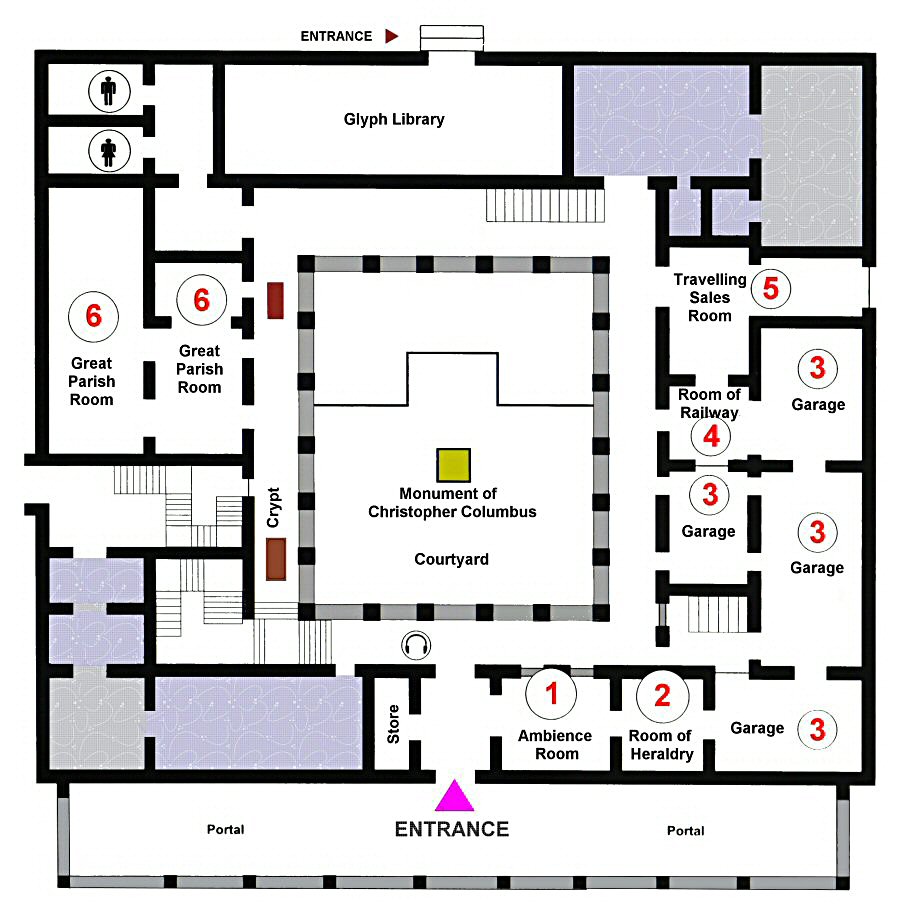
In the
Sala de Ferrocarril (Room of Railway) you will
see the miniature model of the steam locomotive, manufactured by
Cagney Brothers in the USA in 1905. It is exhibited as the
remembrance of the first locomotive that had circulated between
Havana and Bejucal, starting from the Villanueva station on
November 19, 1837. The model of this jewel of the Cuban railway
heritage belongs to the family Loynaz del Castillo. The office
desk of the chief of the train station with the antique cable
phone and the cylindrical hat, forms the nostalgic corner of the
room.
The cart with the name of La Flor del Cerro
(Flower of
the Hill) in the Sala de Comercio Ambulante (Travelling Sales
Room) was used for the sale of charcoal. Some related
objects, such as a cowbell, a portable stove and a pair of
espadrilles are exhibited on the cart. In the same room, the
19th century fire engine, manufactured in London, is on display.
After the stone road sign (Señal de Camino) you will
reach the Sala Parroquial Mayor (Great Parish Room) that
contains the masterpieces of the oldest churches in Havana, as
well as the archeological remains, found during the excavations
on the land of the old church Parroquial Mayor that was standing
in this area before the construction of the Palacio de los
Capitanes Generales. By this way you will have the opportunity
to have a short look at the history of the Christianity on the
island.
The wooden pew in the first room of the Great Parish
Room belongs to the Catedral de la Habana. In the same room the
golden plated monstrance is from the 17th century and ornamented
with red corals. A rather big crystal, embedded at the top, in
the form of the sun, is glancing. It is escorted by two
candlesticks that are made of the same material. The monstrance
and the candlesticks were made in Palermo, Italy. The silver
crismera, the jar with the lid, destined to keep the Holly Oils
and the Chrism, is from the 19th century. The three wooden seats
and the silver wall sheeting behind them are from the 18th
century and belong to the demolished
Convent of Santa Catalina de Sena. The anonymous oil portraits
of the bishops Santiago Echeverría y Elguezúa
Villalobos, and Diego Evelino de Compostela, are hung at the
wall. A Spanish vestment, made in Cuba, is also on display.
The huge wooden candlestick in triangular shape and the
polychrome statue of the Christ, are the most striking objects,
exhibited in the second room of the Great Parish Room that is
bigger than the first. With the bleeding wounds on his body, the
statue of Christ highlights to the humility and the patience. It
is from the 18th century and belongs to the Convent of San Juan
de Letrán.
The showcases are full of masterpieces of silversmiths
of the 18th and 19th century, such as the bible with the silver
cover, the silver crucifix, the big, silver blandones
(candlesticks) and the silver sanctuary. Except the bible, the
rest are the gifts of Juan Lazo de la Vega y Cancino, the bishop
of the Iglesia Parroquial Mayor (1732-1752). On the ground you
will see the bronze plaque that is commemorative of the founding
of the Colonial French Louisiana by Pierre Le Moyne d'Iberville
(El General Dom Pedro Berbila). He died (perhaps of yellow
fever) in Havana in 1706 and was buried in Catedral de la Habana
(Cathedral of Havana).
At the end of the room, there is the commode of
sacristy, made of mahogany, with nice carved drawers. The
drawers were used usually to store the vestments of the priests
of the church. It belongs to the Church of San Agustín in
Havana. Two silver-plated candlesticks and four silver
floróns, produced by Misa brothers,
are placed on the commode. A florón is an
adornment made as a very large flower that is used in
architecture, or a sculpted ornament that represents a leaf or a
flower, particularly in the Gothic style. They
belong to the Cathedral of Havana. The anonymous oil painting of
San Gennaro with the angels is hung over the commode on the
wall. The silver bowl to serve fruits is another masterpiece of
the museum. It is from the 17th century and belongs to the
Parroquial Mayor. The anonymous oil portrait at the wall,
painted in 1788, shows the bishop Santiago Echeverría y Elguezúa
Villalobos placing his hand on the head
of a child during blessing. Towards the exit you will see the
shield of Francisco Fleix y Soláns, the bishop of the
Cathedral of Havana.

